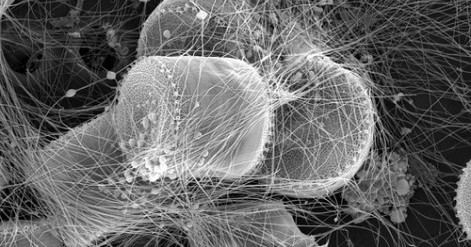I’ve seen quite a few interesting microbiology stories in the news recently and I couldn’t pick just one, so we’ll take a little survey of what’s happening. Most relevant to your immediate future was the recent FDA ban on certain anti-microbials in soaps and other hygiene products. Don’t worry, the bacteria aren’t celebrating; washing with regular soap and water will get rid of just as many of them, and products like alcohol-based hand sanitizers will remain available because they have demonstrated utility. The FDA is simply getting rid of compounds which likely do more harm than good by breeding anti-microbial resistance.
Speaking of resistance, this cool video (source: NPR) illustrates just how quickly (12 days!) bacteria can circumvent our attempts to kill them.
It’s a pretty compelling video. In particular, note how the dosage of antibiotics increases across the surface of the plate. Prolonged exposure to low doses makes it easier for the bacteria to incrementally find a resistance solution. These are exactly the kinds of conditions the FDA is trying to avoid with the new ban. If you don’t completely rinse away the soap with its antimicrobial compounds from every surface, you are likely leaving behind a low dose that will make it easier for resistance to develop. And lest we forget why antibiotics are important, DNA testing recently confirmed that the 1665 Great Plague in London, which claimed roughly 1 out of 4 people in the city, was caused by the bacterium Yersinia pestis. People still get plague infections today, but antibiotics can treat them (for now).

 )
)While many find that video a compelling demonstration of bacterial adaptability, it’s also stirred up some controversy. Not everyone agrees on what it tells us about evolution in general. While the experiment inarguably involves selection, by itself it probably speaks to issues like common descent about as much as any given warm day speaks to anthropogenic climate change. Actually, I think another recent experiment says more about evolution, particularly the ‘why’ questions. Scientists added two chemical “letters” to the alphabet of the genetic code of some bacteria, only to find that they had inadvertently made the bacteria fatally sensitive to visible light. An incremental evolutionary process “in the wild” allows for changes to be evaluated in the full context of all relevant possible effects, rather than just relative to one or two features of interest. Sure, we could posit a God that could perfectly anticipate all possible consequences and plan accordingly, making incremental refinement unnecessary. At the same time, we can also posit a God who wants to show his work, possibly so that his creation could learn how to best achieve our own biological adaptations.
Andy has worn many hats in his life. He knows this is a dreadfully clichéd notion, but since it is also literally true he uses it anyway. Among his current metaphorical hats: husband of one wife, father of two teenagers, reader of science fiction and science fact, enthusiast of contemporary symphonic music, and chief science officer. Previous metaphorical hats include: comp bio postdoc, molecular biology grad student, InterVarsity chapter president (that one came with a literal hat), music store clerk, house painter, and mosquito trapper. Among his more unique literal hats: British bobby, captain’s hats (of varying levels of authenticity) of several specific vessels, a deerstalker from 221B Baker St, and a railroad engineer’s cap. His monthly Science in Review is drawn from his weekly Science Corner posts — Wednesdays, 8am (Eastern) on the Emerging Scholars Network Blog. His book Faith across the Multiverse is available from Hendrickson.

Leave a Reply